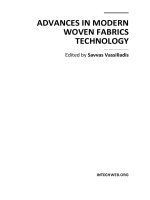Recent Advances in Wireless Communications and Networks Part 1 pptx
Bạn đang xem bản rút gọn của tài liệu. Xem và tải ngay bản đầy đủ của tài liệu tại đây (1012.2 KB, 30 trang )
RECENT ADVANCES
IN WIRELESS
COMMUNICATIONS
AND NETWORKS
Edited by Jia-Chin Lin
Recent Advances in Wireless Communications and Networks
Edited by Jia-Chin Lin
Published by InTech
Janeza Trdine 9, 51000 Rijeka, Croatia
Copyright © 2011 InTech
All chapters are Open Access articles distributed under the Creative Commons
Non Commercial Share Alike Attribution 3.0 license, which permits to copy,
distribute, transmit, and adapt the work in any medium, so long as the original
work is properly cited. After this work has been published by InTech, authors
have the right to republish it, in whole or part, in any publication of which they
are the author, and to make other personal use of the work. Any republication,
referencing or personal use of the work must explicitly identify the original source.
Statements and opinions expressed in the chapters are these of the individual contributors
and not necessarily those of the editors or publisher. No responsibility is accepted
for the accuracy of information contained in the published articles. The publisher
assumes no responsibility for any damage or injury to persons or property arising out
of the use of any materials, instructions, methods or ideas contained in the book.
Publishing Process Manager Niksa Mandic
Technical Editor Teodora Smiljanic
Cover Designer Jan Hyrat
Image Copyright Edyta Pawlowska, 2010. Used under license from Shutterstock.com
First published July, 2011
Printed in Croatia
A free online edition of this book is available at www.intechopen.com
Additional hard copies can be obtained from
Recent Advances in Wireless Communications and Networks, Edited by Jia-Chin Lin
p. cm.
ISBN 978-953-307-274-6
Contents
Preface IX
Part 1 Physcial and MAC Layers 1
Chapter 1 A Study of Cramér-Rao-Like Bounds and
Their Applications to Wireless Communications 3
Kao-Peng Chou and Jia-Chin Lin
Chapter 2 Synchronization for OFDM-Based Systems 23
Yu-Ting Sun and Jia-Chin Lin
Chapter 3 ICI Reduction Methods in OFDM Systems 41
Nadieh M. Moghaddam and Mohammad Mohebbi
Chapter 4 Multiple Antenna Techniques 59
Han-Kui Chang, Meng-Lin Ku, Li-Wen Huang, and Jia-Chin Lin
Chapter 5 Diversity Management in MIMO-OFDM Systems 95
Felip Riera-Palou and Guillem Femenias
Chapter 6 Optimal Resource Allocation in OFDMA
Broadcast Channels Using Dynamic Programming 117
Jesús Pérez, Javier Vía and Alfredo Nazábal
Chapter 7 Primary User Detection in
Multi-Antenna Cognitive Radio 139
Oscar Filio, Serguei Primak and Valeri Kontorovich
Chapter 8 Multi-Cell Cooperation for Future Wireless Systems 165
A. Silva, R. Holakouei and A. Gameiro
Part 2 Upper Layers 187
Chapter 9 Joint Call Admission Control in
Integrated Wireless LAN and 3G Cellular Networks 189
Chunming Liu, Chi Zhou, Niki Pissinou and S. Kami Makki
VI Contents
Chapter 10 Near-Optimal Nonlinear
Forwarding Strategy for Two-Hop MIMO Relaying 211
Majid Nasiri Khormuji and Mikael Skoglund
Chapter 11 Connectivity Support in
Heterogeneous Wireless Networks 221
Anna Maria Vegni and Roberto Cusani
Chapter 12 On the Use of SCTP in Wireless Networks 245
Maria-Dolores Cano
Chapter 13 Traffic Control for Composite
Wireless Access Route of IEEE802.11/16 Links 267
Yasuhisa Takizawa
Part 3 Applications and Realizations 297
Chapter 14 Wireless Sensor Network: At a Glance 299
A.K. Dwivedi and O.P. Vyas
Chapter 15 Software Defined Radio Platform for
Cognitive Radio: Design and Hierarchical Management 327
Amor Nafkha, Christophe Moy,
Pierre Leray, Renaud Seguier and Jacques Palicot
Chapter 16 Dealing with VoIP Calls During “Busy Hour” in LTE 345
Angelos Antonopoulos, Elli Kartsakli,
Luis Alonso and Christos Verikoukis
Chapter 17 A Semantics-Based Mobile
Web Content Transcoding Framework 361
Chichang Jou
Chapter 18 Power Supply Architectures for
Wireless Systems with Discontinuous Consumption 379
Jose Ignacio Garate and Jose Miguel de Diego
Chapter 19 Wireless Sensor Networks in
Smart Structural Technologies 405
Yang Wang and Kincho H. Law
Chapter 20 Extending Applications of Dielectric Elastomer
Artificial Muscles to Wireless Communication Systems 435
Seiki Chiba and Mikio Waki
Preface
Many exciting impacts on our daily life are shortly anticipated due to recent advances
in wireless communication networks that enable real-time multimedia services to be
provided via mobile broadband Internet on a wide variety of terminal devices. The
trend is mainly driven by the evolution of wireless networks and advanced wireless
information and communication technology (ICT). The progression to fourth-
generation (4G) or IMT-advanced systems is expected to significantly change usage
habits and introduce new services, such as the services supported by higher spectral-
efficiency communication technology and self-configurable, high-feasibility networks.
The Third Generation Partnership Project (3GPP) Long-Term Evolution (LTE)
continues to be enhanced as this book is being written.
Although there have been many journal and conference publications regarding
wireless communication, they are often in the context of academic research or
theoretical derivations and sometimes omit practical considerations. Although the
literature has many conference papers, technical reports, standard contributions and
magazine articles, they are often fragmental engineering works and thus are not easy
to follow up. The objective of this book is to accelerate research and development by
serving as a forum in which both academia and industry can share experiences and
report original studies and works regarding all aspects of wireless communications. In
addition, this book has great educational value because it aims to serve as a virtual,
but nonetheless effective bridge between academic research in theory and engineering
development in practice, and as a messenger between the technical pioneers and the
researchers who followed in their footstep.
This book, titled Recent Advances in Wireless Communications and Networks, focuses
on the current hottest issues from the lowest layers to the upper layers of wireless
communication networks and provides “real-time” research progress on these issues.
In my endeavor to edit this book, I have made every effort to ask the authors to
systematically organize the information on these topics to make it easily accessible to
readers of any level. The editor also maintains the balance between current research
results and their theoretical support. In this book, a variety of novel techniques in
wireless communications and networks are investigated. The authors attempt to
present these topics in detail. Insightful and reader-friendly descriptions are presented
to nourish readers of any level, from practicing and knowledgeable communication
X Preface
engineers to beginning or professional researchers. All interested readers can easily
find noteworthy materials in much greater detail than in previous publications and in
the references cited in these chapters.
This book is composed of twenty chapters that were authored by the most
knowledgeable and successful researchers in the world. Each chapter was written in
an introductory style beginning with the fundamentals, describing approaches to the
hottest issues and concluding with a comprehensive discussion. The content in each
chapter is taken from many publications in prestigious journals and followed by
fruitful insights. The chapters in this book also provide many references for relevant
topics, and interested readers will find these references helpful when they explore
these topics further. These twenty chapters are arranged in order from the lowest layer
to the upper layers of wireless communication. This book was naturally partitioned
into 3 main parts. Part A consists of eight chapters that are devoted to physical layer
(PHY) and medium access control (MAC) layer research. Part B consists of five
chapters that are devoted to upper layer research. Finally, Part C consists of seven
chapters that are devoted to applications and realizations.
Chapter 1 is an introduction to topics at an inner receiver in wireless communications,
including a historical perspective and a description of Cramér-Rao-like bounds and
relevant applications to estimation techniques in wireless communications. Chapter 2
conducts a thorough review of the initial synchronization techniques applied to
wireless orthogonal-frequency-division-multiplexing (OFDM) communications.
Chapter 3 is devoted to deeply investigating novel techniques of inter-carrier
interference (ICI) reduction in practical OFDM communications. Chapter 4 is focused
on multiple-antenna techniques from diversity, spatial multiplexing to beamforming
techniques. Chapter 5 deeply investigates diversity management techniques in MIMO-
OFDM communication systems. Chapter 6 thoroughly investigates resource allocation
methods in OFDMA broadcast channels. This is the downlink scenario in either LTE-A
or IEEE 802.16m wireless communications. Chapter 7 is dedicated to primary user
detection in multi-antenna environments. Spectral sensing techniques are considered
as the most important issue in recent research regarding cognitive radios (CRs) or
cognitive networks. Chapter 8 focuses on multi-cell cooperation methodology. In third
generation mobile communications, macro-diversity was investigated. In similar
environments, multi-cell cooperation may be expected in opportunistic communication
networks.
Chapter 9 covers a novel technique on joint call admission control in integrated
wireless local area networks (WLAN) and cellular networks. Chapter 10 is devoted to
studying near-optimal nonlinear forwarding strategies in two-hop MIMO relaying
scenarios. Chapter 11 discusses a research on connectivity support in heterogeneous
wireless networks for next-generation multimedia communication networks. Chapter
12 studies the use of a stream control transmission protocol (SCTP) in wireless
communication networks. Chapter 13 investigates traffic control for composite
wireless access route of IEEE802.11/16 links.
Preface XI
Chapter 14 comprehensively covers wireless sensor networks. Chapter 15 is a
complete study of CRs built by a software-defined radio (SDR) platform. Chapter 16
deals with VoIP calls during rush hours in LTE communications. Chapter 17
demonstrates a semantics-based mobile web content transcoding framework. Chapter
18 proposes novel and effective power supply architectures for wireless
communication systems. Chapter 19 applies wireless communication technology to
smart structural technology. Chapter 20 provides extending applications of dielectric
elastomer artificial muscles to wireless communication systems.
In summary, this book covers broad areas of communications and networks. The
introductions, derivations, discussions and references in this book significantly
improve the readers’ understanding of communications and networks and encourage
them to actively explore these broad, exciting and rapidly-evolving research areas.
Jia-Chin Lin
Distinguished Professor
Dept. of Commun. Engr.
National Central University,
Taiwan, R.O.C.
Part 1
Physcial and MAC Layers
1
A Study of Cramér-Rao-Like Bounds and
Their Applications to Wireless Communications
Kao-Peng Chou and Jia-Chin Lin
Department of Communication Engineering, National Central University
Jhongli, Taoyuan,
Taiwan
1. Introduction
Estimation theory has been developed over centuries. There are several approaches to
utilizing this theory; in this chapter, these approaches are classified into three types. Type I
includes the oldest two methods, the least squares (LS) and moment methods; both of these
methods are non-optimal estimators. The least squares method was introduced by Carl
Friedrich Gauss. Least squares problems fall into linear and non-linear categories. The linear
least squares problem is also known as regression analysis in statistics, which have a closed
form solution. An important feature of the least squares method is that no probabilistic
assumptions of the data are made. Therefore, the linear least squares approach is used for
parameter estimation, especially for low complexity design (Lin, 2008; 2009). The design
goal of the least squares estimator is to find a linear function of observations whose
expectation is a linear function of the unknown parameter with minimum variance. In
addition, the least squares method corresponds to the maximum likelihood (ML) criterion if
the experimental errors are normally distributed and can also be derived from the moment
estimation. As an alternative to the LS method, the moment method is another simple
parameter estimation method with probabilistic assumptions of the data. The general
moment method was introduced by K. Pearson. The main procedure in the moment method
involves equating the unknown parameter to a moment of distribution, then replacing the
moment with a sample moment to obtain the moment estimator. Although the moment
estimator has no optimal properties, the accuracy can be validated through lengthy data
measurements. This is mainly because the estimator based on moment can be maintained to
be consistent. Type II includes the methods of minimum variance unbiased estimator
(MVUE) and the Bayesian approach, which are both optimal in terms of possible minimum
estimation error, i.e., statistical efficiency. MVUE is the best guess of an unknown
parameter. The standard MVUE procedure includes two steps. In the first step, the Cramer-
Rao lower bound is determined, and the ability of some estimator to approach the bound. In
the second step, the Rao-Blackwell-Lehmann-Scheffe (RBLS) theorem is applied. The MVUE
can be produced by these two steps. Moreover, a linear MVUE might be found under more
restricted conditions.
In the Bayesian method, the Bayesian philosophy begins with the cost function, and the
expected cost with respect to the parameter is the risk. The design goal of Bayesian
philosophy is to find an estimator that minimizes the average risk (Bayes risk). The most
Recent Advances in Wireless Communications and Networks
4
common cost function is a quadratic function because it measures the performance of the
estimator in terms of the square of the estimation error. In this case, the Bayes risk is the
mean square error (MSE), and thus, the Bayes estimate is a minimum mean square error
(MMSE) estimator. Another common cost function is the absolute function, which regards
the absolute estimate error as the Bayes risk. In this case, the Bayes estimate is a minimum
mean absolute error (MMAE) estimator. Another estimation, which is not a proper Bayes
estimation but fits within Bayes philosophy, is the maximum a posteriori (MAP) estimation.
The MAP criterion considers the uniform cost function, and the parameter is discretely,
randomly distributed under this assumption. Although this estimate usually only
approximates the Bayes estimate for uniform cost, the MAP criterion is widely used for
estimator design. Type III includes the maximum likelihood (ML) estimate, which is the
most important estimation theory in the 20th century. The ML estimate can be referred to as
an alternative MAP without knowledge of apriori probability of the parameters. The ML
estimator is the most popular approach for obtaining a practical estimator, which was
previously used by Gauss. The general method of estimation was first introduced by R. A.
Fisher with the concepts of consistency, efficiency and sufficiency of the estimation function.
The ML estimator is required when MVUE does not exist or cannot be found. An advantage
of the ML estimator is that a practical estimation is easy to obtain through the prescribed
procedures. Another advantage of this approach is that MVUE can be approximated due to
its efficiency. Thus, from the theoretical and practical perspectives, the ML approach is the
most important and widely used estimation method of this century (Lin, 2003).
Because the ML estimator is essential in estimation theory, the analysis of its performance is
a benchmark of estimator design. This benchmark is commonly known as the Cramer-Rao
lower bound (CRLB), which is named after Harald Cramer and Calyampudi Radhakrishna
Rao. In section 2, the definition of the CRLB is introduced with several examples. A general
case of CRLB under two common communication channels is then introduced in section 3.
To establish basic knowledge of hybrid parameter estimation, random parameter estimation
is presented in section 4. In section 5, Cramer-Rao-like bounds for hybrid parameter
estimation are introduced and compared with each other. Lastly, we summarize some
practical cases and compare these cases with modified CRB which is most common used
Cramer-Rao-like bounds.
2. Cramer-Rao lower bound (CRLB)
The Cramer-Rao lower bound (CRLB) is a lower bound on the variance of any unbiased
estimator. Many other variance bounds exist, but the CRLB is the easiest one to derive and is
thus widely used in many estimation studies. This theory provides a benchmark for
examining the performance of novel estimation algorithms and also highlights the
impossibility of finding an unbiased estimator with a variance less than this lower bound.
Before introducing the definition of CRLB, there is a simple estimation example that may
could help promote understanding of the basic CRLB concept.
Example 2.1
There is a simple signal transmission model with a transmitted signal
s
, a received signal
[]rn
and an additive white Gaussian noise []wn .
[] []rn s wn
=
+ (1)
A Study of Cramér-Rao-Like Bounds and Their Applications to Wireless Communications
5
Here, the index n refers to the n ’th observation. In this problem, the transmitted signal s is
assumed to be an unknown parameter that is deterministic during
n observations. The first
idea estimate
s
takes one observation as our estimation, e.g., the
n
’th observation,
namely
ˆ
[]
srn= . To analyze the estimation accuracy, we check the likelihood function of
[]rn as shown.
()
2
2
2
11
([ ];) exp [ ]
2
2
p
rn s rn s
σ
πσ
⎡
⎤
=−−
⎢
⎥
⎣
⎦
(2)
Substituting the estimator we chose in this likelihood function yields
()
2
2
2
11
ˆˆ
(;) exp
2
2
p
ss s s
σ
πσ
⎡
⎤
=−−
⎢
⎥
⎣
⎦
(3)
Now, the mean value is the target parameter s , and the estimation variance is
2
σ
. The
estimation accuracy can then be determined as
1
2
2
2
ln ( [ ]; )
ˆ
var( )
prn s
sE
s
σ
−
⎛⎞
∂
==−
⎜⎟
⎜⎟
∂
⎝⎠
. (4)
Furthermore, we are interested in finding a more accurate estimator by lowering the
variance
2
σ
. This can be achieved by exploiting multiple observations. Assuming the
observation samples are identical independently distributed, the likelihood function for
multiple observations is
()
()
2
2
2
2
1
11
([ ];) exp [ ]
2
1
2
N
N
p
ns rn s
n
σ
πσ
−
⎡
⎤
=−−
∑
⎢
⎥
⎢
⎥
=
⎣
⎦
r . (5)
A ML estimator can be derived in the same way as for a single observation to yield
1
1
[]
ˆ
N
n
rn
s
N
−
=
∑
=
, (6)
which is an unbiased estimator, namely
{
}
ˆ
Es s
=
. We can also find the estimation variance
using equation (4); the result is similar to the single observation MLs with a factor N in the
denominator:
2
ˆ
var( )s
N
σ
= . (7)
An extreme case occurs when N approaches
∞
, and the process reduces the estimation
variance to 0. From this simple example, we can summarize that the ultimate goal of
estimator design is to find the minimum variance unbiased estimator (MVUE), and if we
wish to illustrate the performance of our estimator, then estimation variance can be found
through the likelihood function. Now, we are ready to define the CRLB (Kay, 1998).
Recent Advances in Wireless Communications and Networks
6
<Theorem>
Assume the pdf,
(; )
p
r
θ
,satisfies the regularity condition
ln ( ; )
0
;
pr
E
r
θ
θ
θ
∂
⎡⎤
=
⎢⎥
∂
⎣⎦
for all
θ
. (8)
Then, the variance of any unbiased estimator
ˆ
θ
has a lower limitation
2
;
2
1
ˆ
var( )
ln ( ; )
r
pr
E
θ
θ
θ
θ
≥
⎡
⎤
∂
−
⎢
⎥
∂
⎢
⎥
⎣
⎦
. (9)
An unbiased estimator may be found that attains the bound for all
θ
if and only if
ln ( ; )
()(() )
pr
Igr
θ
θ
θ
θ
∂
=
−
∂
(10)
for some function
()I
θ
and ()gr . This estimator can be stated as
ˆ
()
g
r
θ
=
, which is a MVUE with
variance
1/ ( )I
θ
. To attain the variance lower bound, Fisher’s information is defined as
()
2
;
2
ln ( ; )
r
pr
IE
θ
θ
θ
θ
⎡
⎤
∂
=−
⎢
⎥
∂
⎢
⎥
⎣
⎦
, (11)
which is used to calculate the covariance matrices associated with maximum-likelihood estimates.
An unbiased estimator that achieves the variance lower bound is referred to as “efficient”.
In other words, an unbiased estimator that achieves the CRLB is an efficient estimator and
must be MVUE. Figures 1 and 2 are illustrations of the relationship between a MVU
estimator and the CRLB.
Fig. 1.
1
ˆ
θ
MVU and efficient
A Study of Cramér-Rao-Like Bounds and Their Applications to Wireless Communications
7
Fig. 2.
1
ˆ
θ
MVU and not efficient
Although there are some theories capable of finding MVUE by sufficient statistics and the
Rao-Blackwell-Lehmann-Scheffe theorem, we will not introduce the details in this chapter.
However, we encourage readers to fully inform themselves concering MVUE from the
references in this chapter (Kay, 1998).
A question may be raised concerning why the minimum variance estimator should be an
unbiased one. Although the unbiased estimator seems to sucessfully find an perfect
estimator
ϕ
because the expectation value approaches the true parameter i.e.,
0
ˆ
[]E
θ
θ
= , but
a biased estimator may outperform than an unbiased one. For example, in some situations,
the relationship between a MVUE and a Bayesian MSE estimator may be illustrated in figure
3.
Fig. 3. MVUE vs. Bayesian estimator
Recent Advances in Wireless Communications and Networks
8
In this example, the Bayesian MSE estimator is an unbiased estimator. The performance
comparison in figure 3 shows that within a certain parameter interval, the biased Bayesian
estimator may have lower estimation variance than MVUE’s. However, this comparison also
shows that the biased estimator performs terribly outside this interval. Thus, the unbiased
estimator has an advantage in terms of consistent performance.
2.1 Asymptotic CRLB
For some cases in which the closed form of the CRLB may not be derived, the asymptotic
CRLB can be used instead; this form can be attained by assuming that infinite observation
samples are available. Under this assumption, we have an observation sample with an
infinite signal-to-noise ratio (SNR).
3. General case CRLB
3.1 Gaussian noise
The AWGN channel is the most common channel model in wireless communication, which
was also used in the example in the last section. In example 2.1, we only consider the
estimate of symbol s . Now, a general form of any parameter
θ
is derived.
Example 3.1
Assuming symbol s is transmitted with a general unknown parameter
θ
and added with
an AWGN
()
n
wt. The signal model is describe as
() (; ) ()
nn
rt st wt
θ
=
+ , (12)
where n indicate the n th observation. Following the general CRLB derivation steps, the
likelihood function is found first and differentiation with respect to
θ
is then performed
twice.
()
[]
1
2
2
1
2
2
11
(();(),) exp ()(;)
2
2
N
n
n
N
n
pr t st r t st
θθ
σ
πσ
−
=
⎡
⎤
=−−
∑
⎢
⎥
⎣
⎦
(13)
[]
1
2
0
ln ( ( ); ( ), )
1(;)
() (; )
N
n
n
n
p
rtst
st
rt st
θ
θ
θ
θ
θ
σ
−
=
∂
∂
=−
∑
∂
∂
(14)
[]
2
2
2
1
22 2
0
ln ( ( ); ( ), )
1(;) (;)
() (; )
N
n
n
n
pr t st
st st
rt st
θ
θ
θ
θ
θ
θσ θ
−
=
∂
∂∂
⎛⎞
=+−
∑
⎜⎟
∂
∂∂
⎝⎠
(15)
Taking the expectation of
2
2
ln ( ( ); ( ), )
n
p
rtst
θ
θ
∂
∂
with respect to
(;, )
p
rs
θ
into Fisher’s information
yields
()
2
2
1
;,
22
0
ln ( ( ); ( ), )
1(;)
=
N
n
rs
n
pr t st
st
IE
θ
θ
θ
θ
θ
θσ
−
=
⎧⎫
∂
∂
⎪⎪
⎛⎞
=−
∑
⎨⎬
⎜⎟
∂
∂
⎝⎠
⎪⎪
⎩⎭
(16)
Finally, the inverse recipocal of the Fisher‘s information produced by the CRLB in the
AWGN channel.
A Study of Cramér-Rao-Like Bounds and Their Applications to Wireless Communications
9
()
2
2
1
0
1
ˆ
var( )
(; )
N
n
I
st
σ
θ
θ
θ
θ
−
=
≥=
∂
⎛⎞
∑
⎜⎟
∂
⎝⎠
(17)
3.2 Complex Gaussian channel
Another commonly seen channel is complex Gaussian channel. The mobile communication
and wireless communication usually introduce the Rayleigh fading due to multipath delay
spread and Doppler shift. In numerical simulation we may use the Jake’s (Clarke) model,
but in theoretical analysis, complex Gaussian channel is more popular, because it has
Rayleigh distributed amplitude with an uniformly distributed phase, which is convenient to
use and without loss of generality.
Example 3.2
The signal model can be extended from the general AWGN channel model. We multiply the
Rayleigh distributed channel gain
0
α
and the uniformly distributed channel phase
0
j
e
φ
−
with the symbol
(; )
u
st
θ
.
0
0
() (; ) ()
j
nun
rt e st wt
φ
αθ
−
=+ (18)
Alternatively, using complex coordinates, i.e., the Gaussian distributed
I
α
and
Q
α
with
mean
A
η
and variance
2
A
σ
yields
() ( )(; ) ()
nIQ n
rt
j
st w t
α
αθ
=
++ (19)
Because the
I
α
,
Q
α
and ()
n
wt terms are Gaussian distributed, the received signal ()
n
rt is
also Gaussian distributed. To find the joint likelihood function, the mean m
r
and variance
2
r
σ
of the received signal should be derived.
(1 ) ( ; )
rA
mjst
η
θ
=
+ (20)
22 2
2(;)2
rAs N
Pt
σ
σθσ
=+ (21)
Here,
*
(; ) (; )(; )
s
P t st st
θ
θθ
= is the power of the transmitted signal. The joint likelihood
function turns out is then described by
2
2
2
1(())
( ( ); ( ; )) exp( )
2
2
r
r
r
r
rt m
prtst
θ
σ
πσ
−
=−
(22)
4. Random parameter estimation
In previous sections, some basic knowledge of estimation bounds were introduced based on
unknown parameters with random interference. These kinds of estimation problems are
categorized in the classical estimation approach. Some properties of estimation methods are
listed in Table 1.
Recent Advances in Wireless Communications and Networks
10
Parameter
types
Sample
distribution
Parameter
distribution
LS Unknown Unknown Non
Moment Unknown Known Non
MVUE Unknown Known Non
Bayesian Random Known Known
MAP Random Known Known
ML Both Known Uniform
Table 1. Some estimation properties
Another research area focuses on random parameters estimation, and several approaches,
including the Bayesian theorem, MAP and ML, are widely used already. One of the most
popular and well-known Bayesian approache is the MMSE estimator. Below, the MMSE will
be briefly introduced with an example.
Example 4.1
Assuming that we received signal
()rt that is composed of a random symbol s and white
Gaussian noise
()wt
, the following relationship can be described.
() ()rt s wt
=
+ (23)
The conditional pdf of ()rt with a priori information can be stated as
1
2
2
0
11
(();) exp ( () )
2
2
N
n
n
p
rt s r t s
πσ
−
=
⎛⎞
=−−
∑
⎜⎟
⎝⎠
(24)
Using Bayes’ rule,
(;())(())
(();)
()
p
srt
p
rt
prt s
ps
= (25)
After certain computations, the conditional pdf with a posteriori information is obtained as
2
;
2
2
;
;
11
(;()) exp ( )
2
2
sr
sr
sr
psrt s
μ
σ
πσ
⎛⎞
=−−
⎜⎟
⎜⎟
⎝⎠
, (26)
where
2
;
22
1
1
sr
s
N
σ
σ
σ
=
+
; (27)
2
;;
22
s
sr sr
s
N
x
μ
μ
σ
σσ
⎛⎞
=+
⎜⎟
⎜⎟
⎝⎠
. (28)
The MMSE estimator is then determined as
;
ˆ
{|()} (1 )
sr s
sEsrt x
μ
ααμ
=
==+− (29)
A Study of Cramér-Rao-Like Bounds and Their Applications to Wireless Communications
11
where
2
2
2
s
s
N
σ
α
σ
σ
=
+
(30)
The Bayesian mean square error is defined as
()
22 2
2
2
2
ˆˆ
() [ ]
s
s
Bmse s E s s
NN
N
σ
σσ
σ
σ
⎛⎞
⎜⎟
=−= ≤
⎜⎟
+
⎜⎟
⎝⎠
(31)
As
2
s
σ
→∞ i.e., without any information from a prior knowledge, the bound would be the
same with the sample mean estimator. This result can be compared with that of the first
example in this chapter, and an important concept of Bayesian estimator is revealed: any
prior knowledge will result in higher accuracy of the Bayesian estimator.
5. Hybrid parameter estimation
In addition to classical estimation and random parameter estimation, there is a more
complicated scenario called hybrid parameter estimation. In hybrid parameter estimation,
the desired parameter is a vector that is composed of several unknown paramters and
random parameters. The parameter vector can be constructed as
T
TT
ru
⎡
⎤
=
⎣
⎦
θθθ
, (32)
where
r
θ is a random parameter vector and
u
θ is an unknown parameter vector. Because
we are considering the random parameters, we assume that we have some prior knowledge
of these parameters, such as the probability distribution function. Several techniques for
calculating hybrid parameter Cramer-Rao like bounds are described below.
5.1 CRLB with nuisance parameter
In our first case,
r
θ is treated as a nuisance parameter, which means that these random
parameter are undesired.
Example 5.1
Reformulating the signal model and likelihood function yields
() (; ) ()
nn
rt st wt
=
+θ (33)
[]
2
2
2
() (; )
1
( ( ), ; ( ), ) exp( )
2
2
n
nr u
rt st
pr t st
σ
πσ
−
=−
θ
θθ
. (34)
Because we assumed that the pdf is well-known and these denoted parameters are
unimportant, the marginal likelihood function is derived first, and the nuisance parameters
are integrated out of the equation.
Recent Advances in Wireless Communications and Networks
12
( ( ); ( ), ) ( ( ), ; ( ), ) ( )
nr u
nu rr
r
p
rtst prt st p d
θ
=
∫
θθθθθ
(35)
Now, the resultant problem becomes a classical estimation problem, and the CRLB can be
derived step by step.
1.
[]
1
)
2
0
ln ( ( ); ( , )
1(,)
() (, )
N
nu
u
nu
n
uu
p
rtst
st
rt st
σ
−
=
∂
∂
=−
∑
∂∂
θ
θ
θ
θθ
(36)
2.
[]
2
2
2
1
22 2
0
ln ( ( ); ( , ))
1(,) (,)
() (, )
N
nu
uu
nu
n
u
uu
pr t st
st st
rt st
σ
−
=
⎛⎞
∂
∂∂
=+−
∑
⎜⎟
∂
∂∂
⎝⎠
θ
θθ
θ
θ
θθ
(37)
3.
()
))
,
ln ( ( ); ( , ) ln ( ( ); ( , )
nu nu
r
ij
ij
pr t st pr t st
IE
θθ
⎧⎫
∂∂
⎪⎪
=
⎨⎬
∂∂
⎪⎪
⎩⎭
θθ
θ
(38)
4.
()
,
1
ˆˆ
() var()
ii
ii
CRLB
I
θ
θ
⎡⎤
=≤
⎢⎥
⎢⎥
⎣⎦
θ
(39)
5.2 Hybrid CRLB
In some scenarios, the effect of these ramdom parameters cannot be ignored. Another
method that considers the joint pdf called joint estimation. The CRLB for this kind of joint
estimation is called hybrid Cramer-Rao bound (HCRB). The derivation process is nearly
identical to that of ordinary CRLB; the likelihood function is determined, and partial
differentiation with respect to the desired parameter is performed twice.
() (; ) ()rt st wt
nn
=
+θ (40)
[]
2
2
2
() (;)
1
((), ;(), ) exp( )
2
2
rtst
n
pr t st
nr u
σ
πσ
−
=−
θ
θθ
(41)
[]
1
2
0
ln ( ( ), ; ( ), )
1(;)
() (; )
N
n
pr t st
st
nr u
rtst
n
σ
−
=
∂
∂
=−
∑
∂∂
θθ
θ
θ
θθ
(42)
[]
2
2
2
1
22 2
0
ln ( ( ), ; ( ), )
1(;) (;)
() (;)
N
nr u
n
pr t st
st st
rtst
n
σ
−
=
∂
∂∂
⎛⎞
=+−
∑
⎜⎟
∂
∂∂
⎝⎠
θθ
θθ
θ
θ
θθ
(43)
Because the joint pdf is considered, the expection of Fisher’s information should be taken
with respect to ( ( ), )prt
r
θ
()
,
,
ln ( ( ), ; ( ), ) ln ( ( ), ; ( ), )
r
nr u nr u
r
ij
ij
pr t st pr t st
IE
θθ
⎧
⎫
∂∂
⎪
⎪
=
⎨
⎬
∂∂
⎪
⎪
⎩⎭
θ
θθ θθ
θ
(44)
The joint pdf ( ( ), )prt
r
θ
is not easy to determine, and an alternative approach using double
layer expectation which computes the expectation with respect to the conditional pdf first.
We define the information matrix with respect to the conditional pdf ( ( ); )prt
r
θ
as
A Study of Cramér-Rao-Like Bounds and Their Applications to Wireless Communications
13
()
0
;
,
ln ( ( ), ; ( ), ) ln ( ( ), ; ( ), )
|
nr u nr u
r
r
ij
r
ij
pr t st pr t st
IE
θθ
⎧
⎫
∂∂
⎪
⎪
=
⎨
⎬
∂∂
⎪
⎪
⎩⎭
θ
θθ θθ
θθ. (45)
Then expectation is computed with respect to ( )p
r
θ
, and all of the random pararameters are
eliminated.
()
() ()
{}
;
,
0
,,
ln ( ( ), ; ( ), ) ln ( ( ), ; ( ), )
|
nr u nr u
rr
ij
r
r
ij
ij
r
ij
pr t st pr t st
IEE
EII
θθ
⎧
⎫
⎧
⎫
∂∂
⎪
⎪⎪⎪
=
⎨
⎨⎬⎬
∂∂
⎪
⎪
⎪
⎪
⎩⎭
⎩⎭
=
θ
θ
θ
θ
θθ θθ
θθ
θ
(46)
Finally, the HCRB is derived as
()
,
1
ˆˆ
() var()
ii
ii
HCRB
I
θ
θ
⎡⎤
=≤
⎢⎥
⎢⎥
⎣⎦
θ
. (47)
5.3 Modified CRLB
During the process of deriving the HCRB, an important step involves taking the inverse of
the Fisher’s information matrix. In some cases, the inverse of the Fisher‘s information matrix
may not exist or cannot be derived into a closed form lower bound. We can then try the
modified or simplified bound, such as the MCRB. Instead of taking the inverse of the matrix
first, we select the desired estimation element from the information matrix first and then
execute the inverse step. After choosing the desired estimation element, the Fisher’s
information is no longer in a matrix form, and derivation is easier.
()
,
1
ˆˆ
() var()
ii
ii
MCRB
I
θ
θ
⎡⎤
⎢⎥=≤
⎢⎥
⎣
⎦
θ
(48)
An previously reported example can help distinguish the difference between these CR-like
bounds (F. Gini, 2000).
Example 5.2
When considering a data-aided joint frequency offset estimation case, the signal model can
be described as
2
() () ()
D
jft
nn
rt Ae st wt
π
−
=+ (49)
Here,
A is the complex channel, which can be rewritten as
0
0
j
IQ
Ae
j
φ
α
αα
−
==+, and
2
D
jf
t
e
π
−
represents the frequency offset. The estimation parameter matrix
[]
T
DIQ
f
αα
=θ
can be defined. Because this is a data-aided case, ()st can be a pilot or
preamble, and we can assume that
*
()() 1
stst
=
without loss of generality. Then the signal
after pilot removal is
2
*
() ()()
() ()
D
n
nn
jft
IQ n
xt rtst
je vtx
π
αα
=
=+ +
(50)









